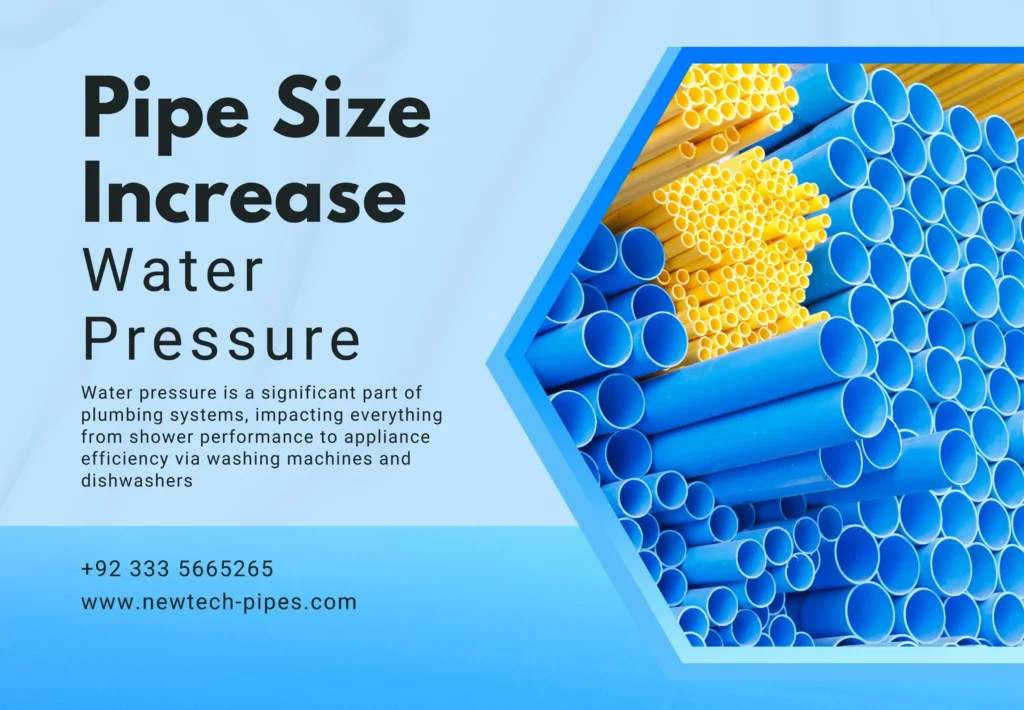Does Bigger Pipe Equal More Water Pressure?
Introduction: Does Pipe Size Matter for Water Pressure?
Water pressure is a significant part of plumbing systems, impacting everything from shower performance to appliance efficiency via washing machines and dishwashers. Most assume that enlarging a pipe will make water pressure bigger, but is this accurate?
This article will discuss the correlation between pipe size and water pressure and how other factors such as pipe material, flow rate, pressure loss, and system design influence water performance. We will also discuss the best way to increase water pressure without losing efficiency.
How Does Pipe Diameter Influence Water Pressure?
Water pressure and flow rate are often confused. While they are related, they are not equal.
- Water Pressure: The pressure water exerts on the pipe walls, usually in pounds per square inch (PSI).
- Flow Rate: The volume of water flowing through a pipe in a given amount of time, measured in gallons per minute (GPM).
When you enlarge a pipe, you are allowing more water through simultaneously. This, however, does not lead to the pressure of the water increasing automatically. In most cases, enlarging pipe diameter slows the water down, which actually decreases the pressure.
For example:
- A ½-inch pipe will handle about 7 GPM at normal pressure.
- A 1-inch pipe will handle up to 27 GPM but at lower velocity.
This means that enlarging pipe size increases water volume and flow rate but not necessarily pressure unless other changes are designed in the system.
Why Does Water Pressure Decrease in Larger Pipes?
One of the most prevalent plumbing myths is that a larger pipe raises water pressure. Intuitively, this makes sense, but the real world is more complex due to fluid dynamics.
1. Relationship Between Pressure and Velocity
According to Bernoulli’s Principle, pressure and velocity have an inverse relationship in a flowing fluid. When you make a pipe larger, water moves more smoothly, slowing its velocity and pressure with it.
2. Pipe Friction Loss
Water in a pipe creates resistance through friction. The larger the pipe, the less friction is experienced per foot travelled. This might help sustain pressure over distances but doesn’t necessarily increase pressure.
3. Static vs. Dynamic Pressure
Static Pressure (measured under no-flow conditions) is the same no matter the pipe size.
Dynamic Pressure (measured during flow) is based on pipe diameter, flow rate, and obstructions.
If water pressure is already low at the source, making the pipes larger won’t solve the problem—it might make it worse by slowing velocity.
What Other Factors Influence Water Pressure?
In addition to pipe size, there are a few factors that control how much pressure you receive at the faucet:
1. Source of Water Supply
- Your home’s water pressure relies heavily on whether you are on:
- A municipal water supply – Typically has a consistent PSI (50-70 PSI) but can vary by location.
- A private well system – Pressure is determined by the well pump and pressure tank settings.
- If the source pressure is low, making the pipes larger won’t solve the problem—it might need a pressure booster pump instead.
2. Pipe Material and Condition
The material of the pipe in your plumbing system is also a consideration for pressure levels:
Copper Pipes: Smooth inner surface reduces friction, providing good pressure.
PEX Pipes: Flexible and durable, with very little resistance.
PVC Pipes: Lightweight, easy to install, but with a tendency to experience pressure loss in long runs.
Galvanized Steel Pipes: Corrosion creates buildup inside the pipe, leading to reduced water pressure over time.
Old or rusty pipes must be replaced to provide proper water flow.
3. Pipe Length and Elevation
Longer pipes experience more friction loss, which reduces pressure at the outlet. Also, if water needs to go up, gravity resists it, leading to further pressure drops.
For multi-story buildings, a gravity-fed system or a booster pump might be necessary to provide strong water pressure.
Does Pipe Size Affect Water Flow in Homes and Buildings?
Pipe size matters to provide homes and buildings with a sufficient amount of water. However, the optimal pipe diameter depends on the specific needs of the plumbing system.
1. Residential Plumbing
In residential homes, standard pipe sizes are ½ inch to 1 inch for water supply lines. Pipe size increase beyond these guidelines may reduce pressure at fixtures. Standard pipe sizes for residential home plumbing:
½-inch pipe: Used for sink supply, toilet supply, and shower supply lines.
¾-inch pipe: Used for main water supply lines in homes.
1-inch pipe: Used for large homes or long-distance water supply.
2. Commercial and Industrial Buildings
Large buildings with lots of stories require a higher-capacity water distribution system. Pipes can be anywhere from 2 inches to 6 inches in diameter, and pressure booster pumps are often used to compensate for pressure loss.
3. Fire Sprinkler Systems
Fire protection systems require high-pressure water supply, usually through 4-inch to 8-inch pipes and dedicated pumps for adequate flow and pressure.
How to Boost Water Pressure Without Pipe Size Upgrade?
If you’re facing low water pressure, there are a few alternatives to pipe size upgrade:
1. Add a Pressure Booster Pump
A booster pump increases water pressure by actively pushing water through the system. This is particularly beneficial for homes with low municipal pressure or multi-story homes.
2. Clear Pipe Clogs
Mineral buildup, rust, or debris in pipes can restrict water flow and lower pressure. Cleaning or replacing clogged pipes can restore your system to optimal condition.
3. Readjust Pressure Regulator
Most homes have a pressure regulator on the main water line. By readjusting this component, you can increase or decrease pressure to meet household needs.
4. Upgrade Main Water Supply Line
Although pipe size increase inside your home won’t boost pressure, main water supply line upgrade (street to house) can boost overall flow, especially in high-water-demand zones.
Conclusion: Does Pipe Size Upgrade Boost Water Pressure?
The answer is straightforward—no, a pipe size upgrade won’t boost water pressure. Instead, it:
✅ Boosts water flow by reducing resistance.
✅ Maintains pressure consistently over long distances.
✅ Low-pressure drop but not source pressure.
If you’re facing low water pressure, first look into pressure booster pumps, cleaning or replacing old pipes, and pressure regulator readjustments before pipe size upgrades. For more plumbing tips, visit NewTech Pipes Blog.


